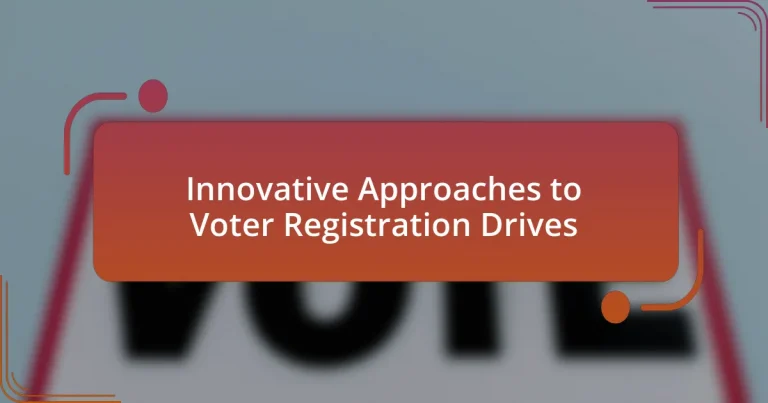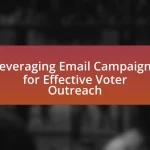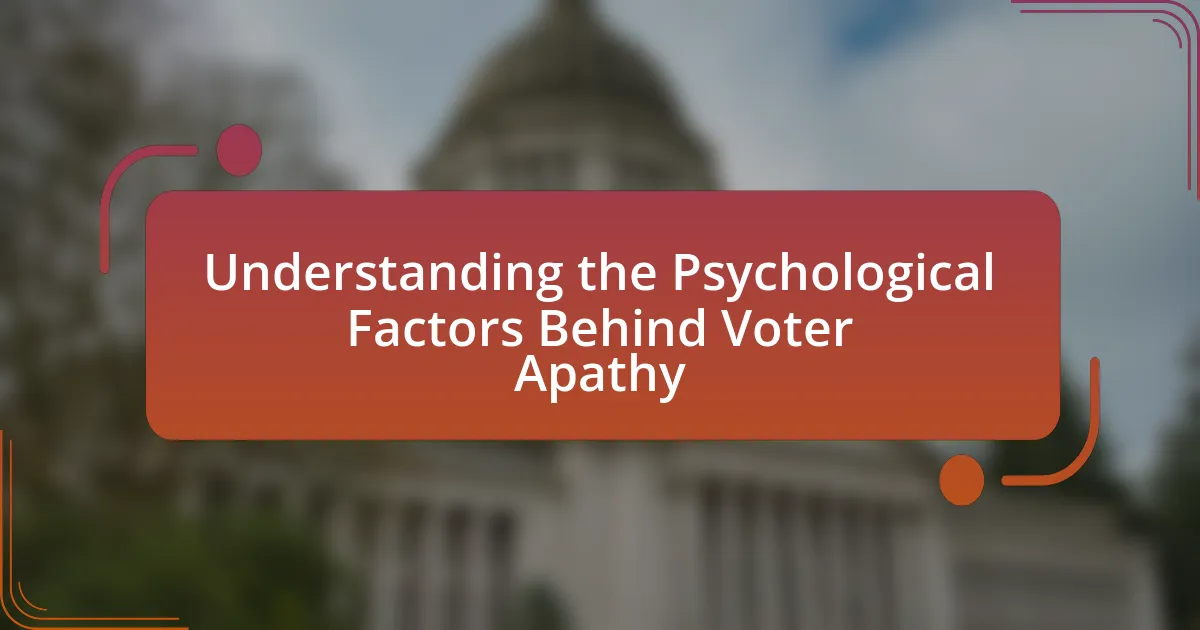Innovative approaches to voter registration drives utilize technology and community engagement to enhance accessibility and participation in the electoral process. Key strategies include online registration platforms, mobile applications, and targeted outreach efforts that effectively reach underrepresented populations. These methods differ from traditional registration by streamlining processes and reducing barriers, leading to increased registration rates and voter turnout. The article explores the characteristics of these innovative strategies, their impact on public perception of voting, and best practices for successful implementation, while also addressing common challenges faced by traditional methods.
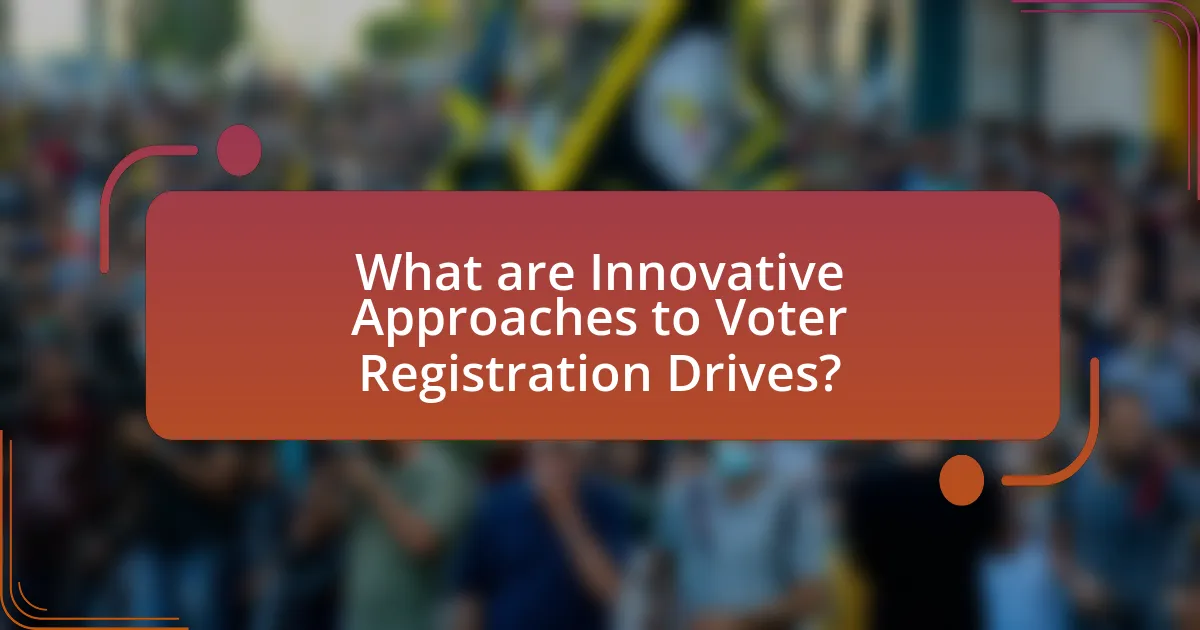
What are Innovative Approaches to Voter Registration Drives?
Innovative approaches to voter registration drives include the use of technology, such as online registration platforms and mobile apps, which streamline the registration process and increase accessibility. For instance, states like California have implemented online voter registration, resulting in a significant increase in registered voters; as of 2020, over 4 million Californians registered online since its launch in 2012. Additionally, community engagement strategies, such as partnerships with local organizations and events, have proven effective in reaching underrepresented populations. Research from the Brennan Center for Justice indicates that targeted outreach efforts can boost registration rates by up to 20% in specific demographics. These methods demonstrate how leveraging technology and community involvement can enhance voter registration efforts.
How do these approaches differ from traditional voter registration methods?
Innovative approaches to voter registration differ from traditional methods primarily in their use of technology and outreach strategies. Traditional voter registration often relies on paper forms and in-person visits to registration offices, which can be time-consuming and limit accessibility. In contrast, innovative methods leverage online platforms, mobile applications, and social media to streamline the registration process, making it more accessible to a broader audience. For example, states that have implemented online voter registration have seen increased registration rates, with a study from the National Association of Secretaries of State indicating that online systems can reduce registration costs by up to 50%. This shift not only enhances convenience but also engages younger voters who are more accustomed to digital interactions.
What are the key characteristics of innovative voter registration drives?
Innovative voter registration drives are characterized by their use of technology, community engagement, accessibility, and targeted outreach. These drives leverage digital platforms, such as online registration and social media campaigns, to reach a broader audience and simplify the registration process. For instance, the National Voter Registration Act of 1993 facilitated online registration, which has significantly increased participation rates. Additionally, innovative drives often involve partnerships with local organizations to engage underrepresented communities, ensuring that efforts are inclusive. Accessibility features, such as multilingual resources and mobile registration units, further enhance participation by removing barriers. Targeted outreach strategies, including data-driven approaches to identify potential voters, have proven effective in increasing registration numbers.
How do technology and social media play a role in these innovations?
Technology and social media significantly enhance voter registration drives by streamlining processes and increasing outreach. Digital platforms enable organizations to create user-friendly online registration forms, making it easier for individuals to register from their devices. For instance, the National Voter Registration Act of 1993 allows states to offer online registration, which has led to increased registration rates; in California, online registration accounted for over 50% of new registrations in 2018. Social media amplifies these efforts by allowing campaigns to target specific demographics, share information rapidly, and mobilize communities through events and reminders. Research from the Pew Research Center indicates that 69% of adults use social media, providing a vast audience for voter engagement initiatives.
Why is innovation important in voter registration drives?
Innovation is important in voter registration drives because it enhances accessibility and engagement, ultimately increasing voter participation. Traditional methods often fail to reach underrepresented populations; innovative approaches, such as online registration and mobile apps, have been shown to significantly improve registration rates. For instance, a study by the Pew Research Center found that states implementing online voter registration saw a 20% increase in registrations compared to those that did not. By leveraging technology and creative outreach strategies, voter registration drives can effectively address barriers and motivate more individuals to participate in the electoral process.
What challenges do traditional voter registration methods face?
Traditional voter registration methods face significant challenges, including accessibility, accuracy, and engagement. Accessibility issues arise from the requirement for in-person registration, which can disenfranchise individuals with mobility limitations or those living in remote areas. Accuracy is compromised due to outdated databases and human errors during data entry, leading to discrepancies that can prevent eligible voters from casting their ballots. Engagement is hindered by a lack of awareness and motivation among potential voters, particularly younger demographics who may not see the value in registering through traditional means. According to the U.S. Census Bureau, in the 2020 election, approximately 20% of eligible voters reported not being registered, highlighting the need for more effective registration strategies.
How can innovative approaches address these challenges?
Innovative approaches can address challenges in voter registration drives by utilizing technology and data analytics to streamline the registration process. For instance, mobile applications and online platforms can simplify access to registration, allowing users to register quickly and efficiently from their devices. A study by the Pew Research Center found that states implementing online voter registration saw a significant increase in registration rates, demonstrating the effectiveness of technology in overcoming traditional barriers. Additionally, targeted outreach using data analytics can identify underrepresented populations, ensuring that registration efforts are focused where they are most needed, thereby enhancing participation in the electoral process.
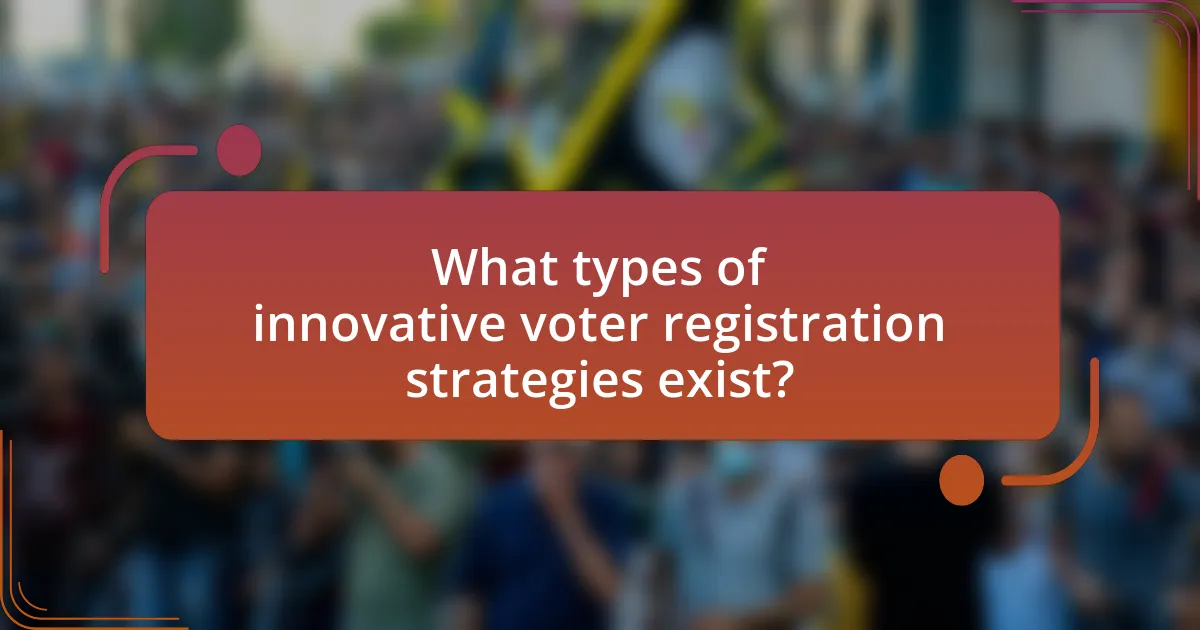
What types of innovative voter registration strategies exist?
Innovative voter registration strategies include online registration, automatic voter registration, same-day registration, and outreach through mobile applications. Online registration allows voters to register via websites, increasing accessibility; for example, 40 states in the U.S. offer this option, significantly boosting registration rates. Automatic voter registration automatically registers eligible citizens when they interact with government agencies, as seen in states like Oregon, which reported a 90% increase in registrations. Same-day registration permits voters to register and vote on the same day, enhancing participation, with states like Wisconsin showing that it can increase turnout by up to 10%. Lastly, mobile applications facilitate registration through user-friendly interfaces, engaging younger voters effectively, as evidenced by initiatives like Vote.org, which has helped millions register through their app.
How do grassroots movements contribute to voter registration innovation?
Grassroots movements significantly contribute to voter registration innovation by leveraging community engagement and localized strategies to increase participation. These movements often utilize social media platforms and grassroots organizing techniques to reach underrepresented populations, effectively addressing barriers to registration. For instance, organizations like Rock the Vote and the League of Women Voters have implemented innovative outreach campaigns that incorporate technology, such as mobile apps and text messaging, to simplify the registration process. Research indicates that these methods have led to increased registration rates, particularly among young voters and marginalized communities, demonstrating the effectiveness of grassroots initiatives in transforming voter registration practices.
What successful examples of grassroots voter registration initiatives can be highlighted?
Successful examples of grassroots voter registration initiatives include the National Voter Registration Act (NVRA) of 1993, which allowed individuals to register to vote while applying for or renewing a driver’s license or public assistance. This initiative significantly increased voter registration rates, particularly among low-income and minority populations. Another example is the “Rock the Vote” campaign, which mobilizes young voters through music and pop culture, resulting in millions of new registrations during election cycles. Additionally, the “Vote.org” platform has streamlined the registration process online, leading to a substantial increase in registrations, especially during the 2020 election, where over 4.5 million voters registered through the site. These initiatives demonstrate effective strategies in increasing voter participation through grassroots efforts.
How do these initiatives engage underrepresented communities?
These initiatives engage underrepresented communities by implementing targeted outreach strategies that address specific barriers to voter registration. For example, they often collaborate with local organizations that have established trust within these communities, facilitating access to resources and information about the registration process. Research indicates that initiatives utilizing culturally relevant messaging and multilingual materials significantly increase participation rates among diverse populations, as evidenced by a study from the Pew Research Center, which found that tailored outreach can boost registration by up to 30% in underrepresented groups.
What role does technology play in modern voter registration drives?
Technology plays a crucial role in modern voter registration drives by streamlining the registration process and increasing accessibility. Digital platforms enable individuals to register online, reducing barriers such as time and transportation, which historically hindered participation. For instance, the National Voter Registration Act of 1993 allowed states to offer online registration, leading to a significant increase in registered voters; states like California reported over 1 million new registrations within a year of implementing online systems. Additionally, mobile applications and social media campaigns enhance outreach efforts, targeting younger demographics who are more likely to engage through digital channels. These technological advancements not only facilitate easier registration but also promote higher voter turnout, as evidenced by studies showing that states with online registration see increased participation rates in elections.
What are the most effective digital tools for voter registration?
The most effective digital tools for voter registration include online registration platforms, mobile applications, and social media campaigns. Online registration platforms, such as Vote.org and Rock the Vote, streamline the registration process by allowing users to complete their applications electronically, significantly increasing accessibility and convenience. Mobile applications like BallotReady provide users with personalized voting information, including registration options, which enhances user engagement. Social media campaigns leverage platforms like Facebook and Twitter to reach a broader audience, encouraging voter registration through targeted ads and shareable content. These tools have been shown to increase registration rates; for instance, a study by the Pew Research Center found that states with online registration saw a 10% increase in voter registration compared to those without.
How can mobile applications enhance the voter registration process?
Mobile applications can enhance the voter registration process by providing a user-friendly platform that simplifies the registration steps and increases accessibility. These applications allow users to register to vote, check their registration status, and receive reminders about upcoming elections directly from their smartphones. According to a study by the Pew Research Center, mobile-friendly registration options can lead to higher registration rates, particularly among younger voters who predominantly use mobile devices for online activities. Additionally, mobile applications can integrate features such as geolocation to help users find their designated polling places, further streamlining the voting process.
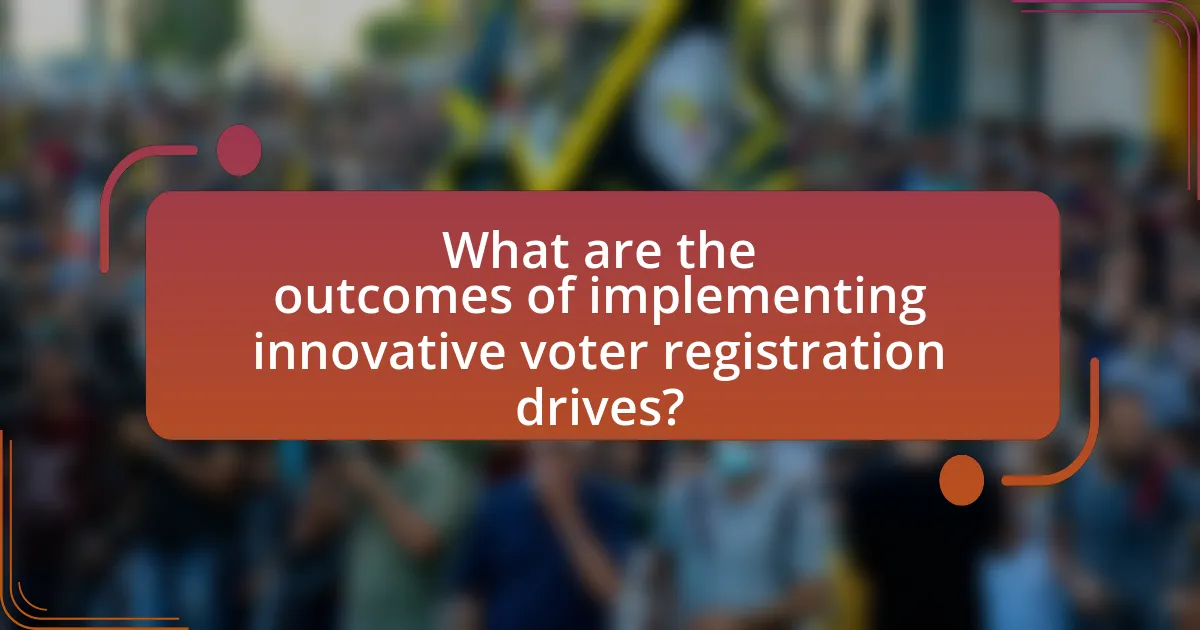
What are the outcomes of implementing innovative voter registration drives?
Implementing innovative voter registration drives leads to increased voter participation and engagement. For instance, research conducted by the U.S. Census Bureau indicates that states employing online registration and same-day registration saw higher turnout rates, with some states reporting increases of up to 10% in voter participation during elections. Additionally, innovative drives often target underrepresented populations, resulting in a more diverse electorate. A study by the Pew Charitable Trusts found that outreach efforts, such as mobile registration units and community partnerships, effectively registered individuals who may not have otherwise participated, thereby enhancing the democratic process.
How do these approaches impact voter turnout?
Innovative approaches to voter registration drives significantly increase voter turnout. For instance, strategies such as online registration, same-day registration, and targeted outreach to underrepresented communities have been shown to enhance participation rates. Research from the U.S. Census Bureau indicates that states implementing same-day registration saw an increase in turnout by approximately 10% compared to those without this option. Additionally, studies by the Pew Charitable Trusts highlight that online registration can lead to higher registration rates, particularly among younger voters, thereby contributing to increased overall turnout.
What evidence supports the effectiveness of innovative voter registration strategies?
Innovative voter registration strategies have been shown to significantly increase voter participation rates. For instance, a study by the National Bureau of Economic Research found that online voter registration led to a 10% increase in registration rates in states that implemented it. Additionally, the use of same-day registration has been linked to higher turnout, with research from the U.S. Census Bureau indicating that states allowing same-day registration saw turnout rates approximately 7% higher than those that did not. These findings demonstrate that innovative approaches, such as online and same-day registration, effectively enhance voter registration and participation.
How do these strategies influence public perception of voting?
Innovative approaches to voter registration drives significantly enhance public perception of voting by making the process more accessible and engaging. These strategies, such as online registration, community outreach events, and social media campaigns, demystify voting and encourage participation. For instance, a study by the Pew Research Center found that states implementing online voter registration saw a 10% increase in registration rates, indicating that simplifying the process positively influences public attitudes towards voting. Additionally, targeted outreach to underrepresented communities fosters a sense of inclusion and empowerment, further improving perceptions of the electoral process.
What best practices can be adopted for successful voter registration drives?
Successful voter registration drives can be achieved by implementing targeted outreach strategies, utilizing technology, and fostering community partnerships. Targeted outreach involves identifying and engaging specific demographics, such as young voters or underrepresented communities, to ensure inclusivity. Utilizing technology, such as online registration platforms and social media campaigns, can streamline the registration process and reach a broader audience. Community partnerships with local organizations can enhance credibility and provide resources for effective outreach. According to the U.S. Census Bureau, states that implemented online voter registration saw a 20% increase in registration rates, demonstrating the effectiveness of these practices.
How can organizations effectively measure the success of their voter registration efforts?
Organizations can effectively measure the success of their voter registration efforts by analyzing the number of new registrations completed, the demographic diversity of registered voters, and the engagement levels during outreach campaigns. Tracking the total number of registrations against set goals provides a clear metric of success; for instance, if an organization aimed to register 1,000 voters and achieved 1,200, this indicates a successful effort. Additionally, assessing the demographic breakdown of new registrants can reveal whether outreach strategies are effectively reaching underrepresented groups, which is crucial for equitable representation. Engagement metrics, such as participation rates in events or follow-up surveys, can further indicate the effectiveness of the messaging and methods used in the registration drives. These metrics are supported by studies showing that targeted outreach can increase registration rates among specific demographics, highlighting the importance of tailored strategies in voter registration efforts.
What common pitfalls should be avoided in innovative voter registration initiatives?
Common pitfalls to avoid in innovative voter registration initiatives include inadequate outreach, lack of accessibility, and insufficient data security. Inadequate outreach can lead to low participation rates, as seen in initiatives that fail to engage diverse communities effectively. Lack of accessibility, such as not providing registration options in multiple languages or formats, can disenfranchise potential voters, evidenced by studies showing that language barriers significantly reduce registration among non-English speakers. Insufficient data security can compromise personal information, leading to distrust in the registration process; for instance, breaches in voter data have been reported in various states, highlighting the need for robust cybersecurity measures.
